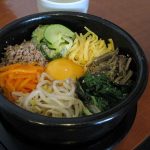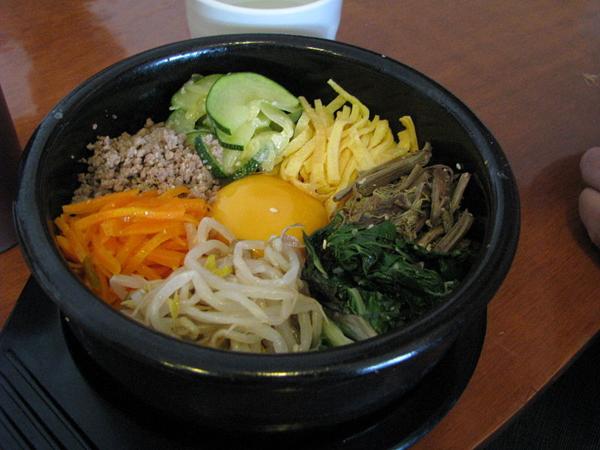
 By Jerine Lay - originally posted to Flickr as Some Korean food, CC BY 2.0, https://ift.tt/3hVAVp9
By Jerine Lay - originally posted to Flickr as Some Korean food, CC BY 2.0, https://ift.tt/3hVAVp9
Korean Bibimbap
Master Ingredient List ¾ to 1 ½ c rice ¾ c kimchi 1 lb steak 2 small carrots 10 oz spinach 8 oz bean sprouts - with beans attached 3 eggs 1 cucumber ¼ c + 2 tsp sesame oil ¼ c ground sesame seeds 1 tsp grated garlic 1 tbsp vegetable oil (peanut, olive, etc) ¼ c soy sauce salt Overview Start the rice cooking in a rice cooker or pot. While the rice is cooking make the namurus (side dishes). Then make the beef soboro. Finally, assemble the ingredients in the bowls and cook them. Grate the garlic and grind the sesame seeds for all the namurus as once. Sesame seeds expand when ground; 2 or 3 tablespoons of sesame seeds will make ¼ cup of ground sesame seeds.Carrot Namul
Ingredients 2 small carrots 2 tbsp sesame oil 2 tbsp ground sesame seeds ¼ tsp grated garlic a pinch or two of salt Procedure Cut the carrots into matchsticks. Boil in salted water for a few minutes covered. Drain. Rinse with cold water until cool. drain again, then put in a bowl. Add the sesame oil, ground sesame seeds, grated garlic, and salt. Mix with your fingers.Spinach Namul
Ingredients 10 oz spinach 1 tbsp sesame oil 2 tsp ground sesame seeds ¼ tsp grated garlic Procedure Put the spinach in a large covered pot with an inch of water. Bring to a boil and cook as usual. Stir occasionally to keep the spinach from sticking to the pot. The spinach is done when it's dark green and reduced to a small fraction of its original volume. Drain the cooked spinach. Cool by adding cold water to the pot and drain again. Squeeze the spinach in your hands to remove the water. Slice the cooked spinach into 1-inch pieces. Put the cooked spinach in a bowl with the sesame oil, ground sesame seeds, and grated garlic. Mix with your fingers.Bean Sprout Namul
Ingredients 8 oz bean sprouts 2 tsp sesame oil 1 tsp ground sesame seeds ¼ tsp grated garlic a pinch of salt Procedure Blanche the bean sprouts in a pot of salt water until they become clear. Drain and put the cooked sprouts in a bowl. Dress with sesame oil, ground sesame seeds, grated garlic, and salt.Beef Soboro
Ingredients 1 tbsp olive oil (peanut, vegetable, etc) 1 lb steak ¼ c soy sauce 1 tbsp sesame oil 1 tbsp ground sesame seeds ¼ tsp grated garlic Procedure Slice the steak thinly, but not paper-thin. Heat the oil in a large frying pan on high. When the oil is hot, but not smoking, add the beef. Stir-fry. While the beef is cooking, add the sesame oil, ground sesame seeds, and grated garlic. Cook until the meat is well browned. Add the soy sauce. Continue cooking until the liquid has boiled off.Egg Topping
Cook eggs over easy to your own personal preference. Serving Place rice in each bowl and add ingredients separately to sit on top in a color pleasing setting along with the chopped uncooked cucumbers. The egg sits in the middle. kochujang, kimchi and any other root or leafy vegetable is served on the side in small individual bowls for the table to help themselves.Dolsot Bibimbap
If using dolsots to serve your Bibimbap the preparation is slightly different as it is a hot version of the meal so the process will heat the vegetables again. Rub the inside of the dolsots with sesame oil. Spread the cooked rice evenly over the bottom of the dolsots and part way up the sides. Place the namurus and the beef soboro on top of the rice, each in its own area. Cover the dolsots and cook over medium-high heat. Watch carefully near the end to avoid burning the rice on the bottom. To test, use a spoon to scrape the rice from the side. Remember that the bottom cooks more than the sides and that the rice keeps cooking after you remove it from the heat. Do no preheat the dolsots. Add an uncooked egg to the middle of each dolsot. Place dolsots on small pieces of wood to keep the heat from damaging the table. To eat, start by scraping the rice from the bottom and stirring the ingredients together with a metal spoon. The egg will cook as it breaks up. The rice on the bottom will be crunchy and sometimes hard to remove unless you continue stirring as you eat. Alternative Ingredients Vegetables that can be served on the side (in small individual bowls) include lettuce (instead of cucumber), Shitake Mushrooms, Duraji Namul, Kong Namul, Gaji Namul, Sukju Namul, Gosari Namul, and Hobak Namul. Other ingredients like dried sesame seeds, seaweed (gim: dried in paper thin sheets and often seasoned) are added to the mix at varying times, depending on personal taste. References trifood.com inda2japan.com koreanspices.com lifeinkorea.com Source: https://ift.tt/3hVAVWbSource: Business Diary Philippines



0 Comments